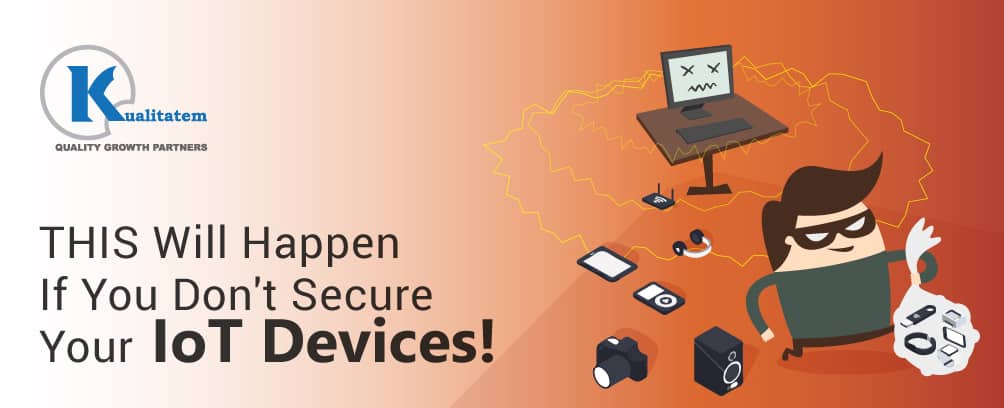THIS Will Happen If You Don’t Secure Your IoT Devices!

- March 6, 2018
- Kualitatem
Ok, answer this first: What do you think is the most pressing IT challenge in 2018? Your pat answer would be something around having to deal with technologies like Blockchain, AI, Big Data, or maybe the underlying difficulties in deploying hybrid cloud architecture. Yes, these are there too, but with the passage of time, these difficulties would no longer be hard to handle.
If you dig down deep, you’ll notice that every technology has a difficult forthcoming problem lying at its core and that’s how to secure the rapidly-evolving ‘Internet of Things’. Simplifying it further, IoT ranges from your existing smart devices, including mobile phones, consumer gadgets, and other household items, like your coffee-maker and the escalating state of industrial IoT.
The global IoT market is growing at a fast pace, with the growth rate increasing from $157B in 2016 to $457B by 2020. With this upsurge, the need to protect IoT devices against attacks isn’t just out of concern for losing personal data, as in the case of a threat from someone hacking them. The prospective impact of an IoT security breach is massive. Recall the Bitcoin incident last year that caused $64m in cryptocurrency stolen in a highly sophisticated’ hack. Alarming enough for decades to come, no?
IoT abuses could go beyond this! Sophisticated hackers could penetrate into your driver-less car’s system, your daughter’s smartphone, your security system at work or home, your father’s pacemaker, and worse of all, your coffeepot…all at the same time! What will happen if all the coffee machines in the entire country suddenly go out-of-order, kaput the same time, depriving you of your morning dose? What if the whole tightly-secured stock exchange system crashes? Can you imagine all this loss only because of all the not-so-secure IoT devices?
Not to scare you, but remember that 2003 power breakdown that impacted more than 50 million residents in New England? Well, that happened because of a bug in the alarm system at the control room of FirstEnergy Corporation. An incapability to fix something as quickly as it has occurred at such a huge level could easily make one be forced to predict a rather bleak future.
V for Vulnerability!
It’s not those massive, direct attacks that are troublesome. Basically, what can cause a greater loss are those slow, sneaky assaults occurred through security breaches of IoT devices.
With the number of IoT devices in use increasing by leaps and bounds, the attack surface will be too outsized to keep everything under a fully secured umbrella. In 2017, there have been gigantic security breaches in websites with apparently well-structured security firewalls. Unfortunately, if the focus was on ensuring the security of IoT devices instead of emphasizing only on building secure infrastructure, perhaps the number of breaches might not have been this large.
It is obvious now that our IoT future will not depend on one secure, unbreachable standard, rather we need a substantial number of security protocols and robust network architectures to stay secured in the game.
A whole new world of advanced treachery
Getting in the way of different services
We should be prepared for that fact that IoT will face different sorts of denial-of-service attacks. Hackers may perhaps try to intercept communications, redirect protocols, delay data streams, crush gateways, introduce unwarranted network failures, and worse, may even physically damage devices. To understand this phenomenon better, take the example of being locked down because of multiple attempts using a wrong password. What will happen if some perpetrator gains access to all your IoT devices and blocks you from using them? Imagine the damage it can cause…
Tampering with data integrity
It is quite plausible that different kinds of attacks will likely tamper the data streams gathered from edge devices. The point might not necessarily be used for destroying crucial data from any specific device, but, instead, enact some other kind of scam by modifying data. Verification and encryption serve the security purpose up to a certain level, however, it won’t be difficult to introduce unwanted “things” into an IoT network. Targeting gateway data accumulation points is very easy and if the attackers successfully penetrate, they can without any difficulty modify data and gain full control over data streams over the entire edge device. With the IoT devices are not fully secure, billions of different things connected together will likely be physically compromised.
Taking over the devices
Botnets already facilitate in eradicating a great deal of spam, so creating new IoT botnets would be a piece of cake for future hackers. Even if downright larceny or taking complete control of the devices is the real intention, the attackers will still be able to derive harassment, demand ransom or probably even indulge in some sort of vicious physical acts, for instance changing the password for your home security lock system or deliberately accelerating the speed of your self-driven car.
Every cloud has a silver lining!
Even though all this will take place if we don’t pay heed to security vulnerabilities, or take the matter casually, but we cannot deny the fact that the efforts in the field of application security have put us in a more secure place than we were before. At present, we have a highly-advanced encryption process in the form of blockchain technology, plus we cannot ignore the advanced security auditing processes. With the passage of time, the IoT communications will enhance further and so we can expect to see some new protocols emerge for increased level security policy implementation or a more robust security mechanism in place.
According to a study conducted by HP in 2014, it was estimated that 70 percent of IoT devices were vulnerable to attacks. One of the biggest challenges right now includes expanding the orbit of IoT Testing, in order to cover as many IoT Devices as possible.
Let’s just hope that everything we imagined and supposed upon doesn’t really happen, otherwise, you’ll have to stay deprived of your morning coffee for an infinite time till the issue gets resolved. Even if it seems unbelievable for some, it, in fact, is every bit possible from a technical perspective.
Let’s psych yourself up to start creating essential IoT device security fundamentals.











